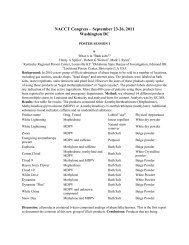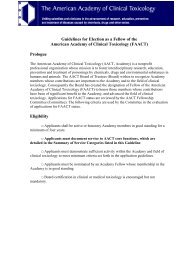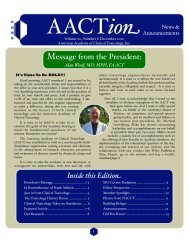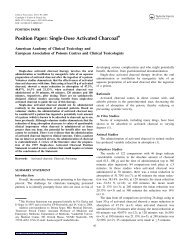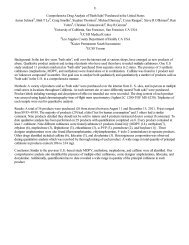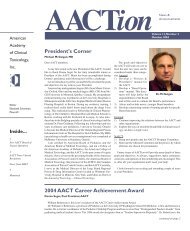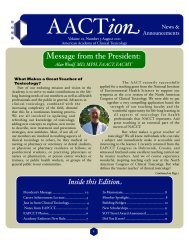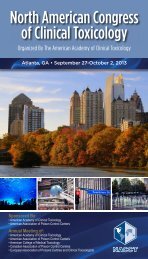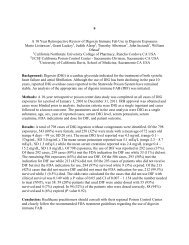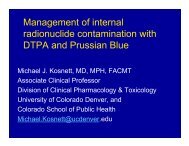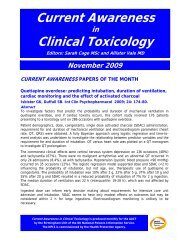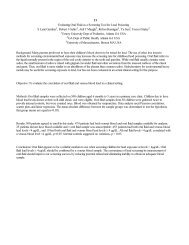Posters IV - The American Academy of Clinical Toxicology
Posters IV - The American Academy of Clinical Toxicology
Posters IV - The American Academy of Clinical Toxicology
Create successful ePaper yourself
Turn your PDF publications into a flip-book with our unique Google optimized e-Paper software.
ADR's initially categorized as "allergies" 211/274 (77%)<br />
% changed to side effects 59/211 (28%)<br />
% <strong>of</strong> patients that could tolerate the medication 25/59 (42%)<br />
% changed to precautions 15/211 (7%)<br />
% changed to preference 2/211 (1%)<br />
ADR's not been previously documented 15/274 (5%)<br />
Conclusions: Parents may inaccurately present a patient's adverse reaction pr<strong>of</strong>ile, and the nature <strong>of</strong> the<br />
ADR may not be verified by the health care provider. This perpetuates the problem and precludes the<br />
patient from receiving an appropriate medication for the patient and the disease. Utilization <strong>of</strong> a program<br />
that accurately characterizes the reaction and medication with the reaction may allow patient's to receive<br />
appropriate medications in their future.<br />
286<br />
Partnership with Public Health Agencies Creates Opportunity to Educate Populations Underutilizing<br />
Poison Center Services<br />
Lizette Villarreal 1 , Virginia Barrera-Garcia 1 , Carmen Jimenez 1<br />
1 University <strong>of</strong> Texas Health Science Center San Antonio, San Antonio TX USA<br />
Background: Integrating public health into poison center (PC) activities has become a focus for PCs<br />
across the country. By participating in Operation Lone Star (OLS), our PC provided poison prevention<br />
education to parents, caregivers, and others in counties that are majority Hispanic, Spanish-speaking, and<br />
medically-underserved areas <strong>of</strong> South Texas. Methods: Our PC partnered with public health agencies<br />
across the state to increase awareness related to the importance <strong>of</strong> utilizing PC services among OLS<br />
attendees. This two-week event is a joint project between various agencies including state health and<br />
human services agencies, TX State Guard, Army and Air National Guard, county health departments,<br />
local service groups and civilian volunteers that provide medical services such as free medical and dental<br />
exams, vaccines, and immunizations to people in the community and the operation serves as training for<br />
emergency planning. This intensive event covers six counties and is the largest humanitarian effort <strong>of</strong> its<br />
kind in the US. Due to wait times, our PC took the opportunity to educate those attending the event.<br />
Results: A major disparity exists in the language <strong>of</strong> callers utilizing PCs versus the actual percent <strong>of</strong> the<br />
population in our state that speaks Spanish. PC call data for our state indicates that only 1% <strong>of</strong> calls are<br />
from the Spanish-speaking community; although, 29% <strong>of</strong> the population 5 years old and over speak<br />
Spanish in their home. <strong>The</strong> population reached by OLS was a majority Spanish speaking. Over a twoweek<br />
period, community educators targeted six counties and reached 12,179 people. Table 1 provides<br />
census data on the composition <strong>of</strong> each county and a breakdown <strong>of</strong> the number reached. Spanish language<br />
calls originating in our region have increased by 220% from 444 in 2001 to 1,421 in 2010. <strong>The</strong> increase in<br />
2010 may be attributed to educational projects such as Operation Lone Star that provide education aimed<br />
at the Spanish speaking population. Conclusions: Since regional PCs encompass a large group <strong>of</strong> counties<br />
across a state, it is important that partnerships with public health entities be established to reach people<br />
that are currently underutilizing PC services. This project highlights the effectiveness <strong>of</strong> an initiative that<br />
reached a specific population over a relatively short period <strong>of</strong> time and attributed to positive outcomes.<br />
Table 1: Demographics <strong>of</strong> Counties Targeted



